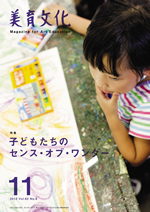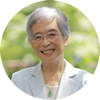
「海の水はなぜ塩辛いの?」「青い空はどうして夕方になると赤く色づいてくるの?」「円い地球を端まで歩いていくと何で落っこちてしまわないの?」「空から星が落ちてこないのがなぜ?」「お昼になるとなんでおなかがすくの?」「世界にはどうしてたくさんの言葉があるの?」「お花は何のために咲くの?」「チョウチョはなぜ死んでしまうの?」…このように世界は素朴な疑問に溢れています。そして、ここには答えがありそうなものがある一方、簡単には答えられない問題もあります。
そのような多様な疑問に出会うとき、私たちはつくづく世界が不思議に充ちていることを感じずにはいられません。けれども成長とともに、人は不思議だと思う感覚から次第に遠ざかってしまいます。そして私たちは、いつしか、既知の法則や論理や理念などを学ぶことで、世界の解釈は可能であると断定することにより、「不思議だ…」という身体的感覚によって獲得した実感から切り離されていきます。
ところで、表現教科である図工・美術では、表現者の内部に豊かな感情や感覚が培われている必要があります。
まず感じる力がなければ表現はおぼつかないでしょう。造形教育では、世界に対する素朴な疑問からはじまる問いや学びのプロセスが、大切であると考えます。それは子ども自身の経験そのものが、自分の内部で再構成され、子ども自身の感覚や感情、知識などを形づくっていくと考えるからです。
『沈黙の春』によって化学物質による環境汚染の危険性を早くから訴えたレイチェル・カーソンは、自然を見つめる中で「不思議だ」と感じる感性を「センス・オブ・ワンダー」と名づけました。自然に敬意を払い、共生していくなかで、この感覚を育てることが豊かな人格の形成に必要であることを指摘しています。この号では子どものセンス・オブ・ワンダーについて造形教育の立場から考えます。
“Why is seawater salty?” “Why does blue sky turn red in the evening?” “Why do we not fall off when we walk to the edge of the round earth?” “Why do we get hungry at noon?” “Why are there so many languages in the world?” “What do flowers blossom for?” “Why do butterflies die?” The world is full of these naive questions. There are some questions with answers, but also some questions that you cannot answer easily.When we are faced with a wide array of questions, we always feel that the world is full of wonders. However, as we grow up, we gradually forget these questions. And eventually, we become cut off from the actual feelings of wonder that we experienced physically, because we conclude that we are able to interpret the world with the laws, logic, and ideas that we have learnt.ZUKO・Art education as a subject of expression should cultivate the rich feelings inside of a person who create. If the person doesn’t have enough feelings, their expression can be vague. We believe that those processes of study from naive questions about the world are very important in creative education. This is because we believe that children form their own senses, feelings and knowledge through the rebuilding of their own experiences internally.Rachel Louise Carson, who wrote the book “Silent Spring” and warned about the dangers of environmental pollution from chemicals, called the experience that comes when staring at nature “ the sense of wonder”. She points out that we need to cultivate this sense for the development of the rich shape of one’s character while respecting and living in symbiosis with nature. In this issue, we consider children’s sense of wonder from the viewpoint of creative education.

上遠 恵子さん(レイチェル・カーソン日本協会会長)
…本誌で
特集 子どもたちのセンス・オブ・ワンダー1 PHOTO & ESSAY
レイチェル・カーソンからの贈り物
上遠 恵子(レイチェル・カーソン日本協会会長)
写真:小西 貴士(写真家)
p06
2 特集・子どもたちのセンス・オブ・ワンダー
ミクロコスモスを形成するものとしての自然体験 汐見 稔幸 p12
「センス・オブ・ワンダー」からはじまる 槇 英子 p16
土を使った幼児の造形表現 山田 温子 p20
知り尽くせないことを感じる力 古賀 琢也 p22
眠った記憶を呼び覚ます「土」のちから あつみけいこp24
3 世界児童画展 ギャラリー
アメリカ 日本 ポーランド p284 NEW 連載 授業ライブ・第2回
かわいいコレクション〈2年生〉
東京・新宿区立落合第六小学校
横内 克之
p30
5 授業研究
幼児 美的感動教育 坂本 行正 p32
小学校低学年 カラフルアイス、コロコロツルーリ 堀江美由紀 p34
小学校中学年 音と光がきらめいて世界が生まれる 木村 早苗 p36
小学校高学年 糸のこみんなでドライ 森實 祐里 p38
中学校 こんな世界に…荒川 洋子 p40
6 連載・第9回 図説 子どもART学
子どもたちのセンス・オブ・ワンダー
辻 政博
p42
7 連載・第17回
〈美術/教育〉の扉をひらく
メディア社会のヴィジュアル/ メディア・リテラシー(下)
―新しい社会文化システムの中へ―
メディア社会のヴィジュアル/メディア・リテラシー
長田 謙一
p44
8 東日本大震災 復興日誌・第9回
7.24-9.5
小野 浩司
p48
9 新刊紹介
『美術館活用術 ~鑑賞教育の手引き~』
ロンドン・テートギャラリー 編
奥村 高明・監訳 一條 彰子 p50
『太陽旗下的美術課 台灣日治時代美術教科書的歴程』
楊 孟哲 著 林 永利 p51
10 2012年 美育文化総目次 p52
11 BIIKU NEWS
美育ニュース p54
台湾訪問記
―2012高雄市児童芸術教育節報告―
奥村 高明 p56